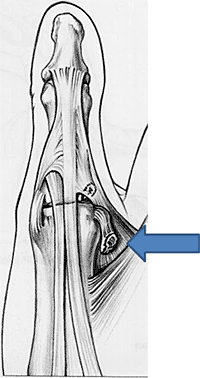
Skier's Thumb
Skier’s thumb used to be called “gamekeeper’s thumb”. However, the #1 cause of this injury is currently skiing, leading to the name change. Skier’s thumb is an injury to the ulnar collateral ligament of the thumb’s metacarpophalangeal (MP) joint, the big joint where the thumb attaches to the hand. Ligaments are the structures that stabilize joints. Every finger joint has ligaments that stabilize it: collateral ligaments on either side and a volar plate on the palmar aspect that prevents hyperextension. These three ligaments are oriented to form 3 sides of a box around joints.
Skier’s thumb most often occurs from a fall onto the thumb, especially if the thumb gets bent back by the ground, a ski pole, or anything else that pulls the thumb away from the hand and stresses the ulnar collateral ligament.
The ulnar collateral ligament is an important structure that provides thumb stability when pinching or gripping. When the ulnar collateral ligament is injured, pain and weakness, often accompanied by swelling, is experienced when using the thumb to pinch, grip, lift or twist. This compromises the ability to use the hand.
If the ligament is only partially torn it can heal without surgery. Partial tears of the ulnar collateral ligament are best treated in a short cast for 3 weeks, followed by 3 weeks of splinting. If the ligament is completely torn it is best to have it repaired surgically (Figure 15). This is a quick outpatient procedure with a very high success rate. Surgical repair is also followed by 3 weeks in a cast followed by 3 weeks of splinting.
Skier’s Thumb Repair
After surgery, the cast should be kept clean and dry. Bathing is safer than showering, because the hand can be kept out of the bath tub. Wrap a towel around the hand and then place it inside a plastic bag secured with rubber bands. If a bathtub is not available, the best cast protector is made by Walgreens.
Like most injuries, if ignored, a complete ulnar collateral ligament tear becomes more difficult to treat once time has passed. This is because over time the torn ligament becomes resorbed by the body, so that it is no longer available to be repaired. The joint subluxes (partially dislocates) because the ligament is no longer stabilizing it, which can lead to arthritis. Treatment of old, chronic ulnar collateral ligament tears involves taking a tendon from the forearm (a ‘spare part’) and using it to reconstruct the ulnar collateral ligament that is no longer present. While repair of the natural ligament works better than reconstructing it with a tendon, this tendon reconstruction usually leads to significant improvement in thumb pain and function, although some slight laxity usually persists.
In summary: Skier’s thumb is a common ligament injury that can be predictably treated when seen quickly. If neglected, satisfactory treatment options are still available.



